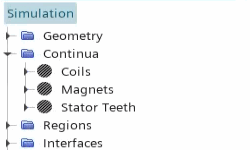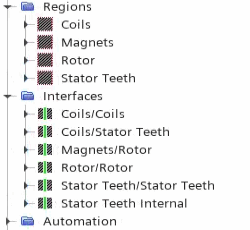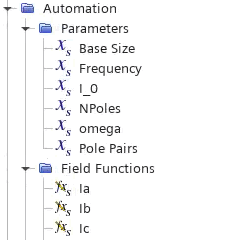Loading the Initial Simulation
For this tutorial, you are provided with a simulation file that contains predefined objects.
- Launch a double precision version of Simcenter STAR-CCM+.
- Select
- In the Load Simulation dialog, click Browse...
- In the Open dialog, navigate to the electromagnetism folder of the downloaded tutorial files.
-
Select AxialFluxMachineHO_start.sim then click
Open.
You are recommended to run this tutorial in parallel, using at least 4 cores.
- In the Load Simulation dialog, click OK.
-
You can review the predefined settings by expanding the relevant nodes:
- Physics Continua
- The starting file contains three solid
continua to define the physics of the coils, magnets, and stator
teeth. Each use the Finite Element Magnetic Vector
Potential and Ohmic Heating
model, alongside other specific models:
- Coils—Finite Element Excitation Coil and Excitation Coil Lumped Parameter models to calculate the electric current density produced by the coils and other quantities of interest.
- Magnets—Permanent Magnet model to simulate the magnetization direction of the magnets.
- Stator Teeth—Laminated Steel model to simulate the eddy currents in the laminated material.

- Regions and Interfaces
- The starting simulation includes solid
regions for the magnets, double-rotor, coils, and stator teeth, as
well as the interfaces between these regions. The interfaces are a
mixture of in-place and periodic interfaces.

- Parameters and Field Functions
- The majority of the required parameters
and field functions are provided in the starting simulation.
Ia, Ib, and
Ic field functions define the three phase
harmonic current supplied to the coils as:
- Save the simulation as AxialFluxMachineHO.sim.
